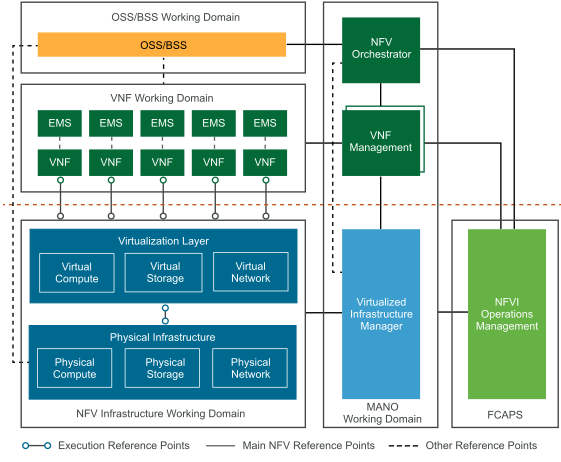NFV is an architectural framework that is developed by the ETSI NFV Industry Specification Group. The framework aims to transform the telecommunications industry through lower costs, rapid innovation, and scale.
The NFV framework provides a standardized model that moves away from proprietary, purpose-built hardware that is dedicated to a single service, toward network functions that are delivered through software virtualization as virtual network functions (VNFs) with commercial off-the-shelf (COTS) hardware. The result is a network that is more agile and better able to respond to the on-demand, dynamic needs of telecommunications traffic and services. The framework identifies functional blocks and the main reference points between these blocks. Some of these are already present in current deployments, while others need to be added to support the virtualization process and operation.

NFV Infrastructure (NFVI)
The Network Functions Virtualization Infrastructure (NFVI) is the foundation of the overall NFV architecture. It provides the physical compute, storage, and networking hardware that hosts the VNFs. Each NFVI block can be thought of as an NFVI node and many nodes can be deployed and controlled geographically. NFVI nodes are deployed at multiple sites and regions to provide service high-availability, and to support locality and workload latency requirements. The hypervisor provides a virtualization layer that allows for workloads that are agnostic to the underlying hardware. With this approach, operators select hardware from their preferred vendors at competitive prices, and upgrade hardware independent of its workloads.
Management and Orchestration (MANO)
The Management and Orchestration (MANO) functional block is responsible for the management of all the resources in the infrastructure along with the orchestration and life cycle management of VNFs. These elements support the infrastructure virtualization and life cycle management of MANO VNFs, with a focus on the virtualization specific management tasks necessary to the NFV framework.
- Virtualized Infrastructure Manager (VIM)
- The Virtualized Infrastructure Manager (VIM) is a functional block of the MANO and is responsible for controlling, managing, and monitoring the NFVI compute, storage, and network hardware, the software for the virtualization layer, and the virtualized resources. The VIM manages the allocation and release of virtual resources, and the association of virtual to physical resources, including the optimization of resources. The complete inventory of the NFVI is maintained in the VIM, including the linkage and relationship between components as they relate to an instance of a VNF workload, to allow for monitoring in the context of a single VNF.
- Virtual Network Functions Manager (VNFM)
- This document does not cover the Virtual Network Functions Manager (VNFM) functional block. For information about the VNFM functional block, refer to the publicly available ETSI NFV Standards.
- Network Functions Virtualization Orchestrator (NFVO)
- This document does not cover the NFV Orchestrator (NFVO) functional block. For information about the NFVO functional block, refer to the publicly available ETSI NFV Standards
Virtualized Network Functions (VNFs)
This document does not cover the Virtualized Network Function (VNF) working domain. For information about the VNF working domain, refer to the publicly available ETSI NFV Standards
Operations Support Systems and Business Support Systems (OSS/BSS)
The vCloud NFV OpenStack Edition platform exposes APIs that can be consumed from one or multiple operations support systems and business support systems (OSS/BSS). These are not described in this document. For information about APIs that can be consumed from the OSS/BSS working domain, refer to the publicly available ETSI NFV Standards.